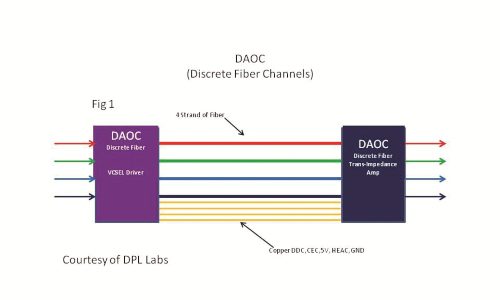It seems like the flood gates opened with HDMI active optical cable (AOC) transmission products for testing here at DPL Labs recently. They come in all kinds of flavors from colors — and I do mean colors as in lit up — to a host of features. From a performance standpoint some make it past DPL limits and others don’t.
Integrators need to be aware of the product differences, which can get confusing. Within the HDMI fiber category there are basically two types of offerings — Discrete AOC (DAOC) and Wave Division Multiplex AOC (WAOC). They can both perform very well; however, WAOC has a distinct distance advantage over DAOC.
Figs. 1 (above) and 2 (below) are two very simple block diagrams showing their makeup. Fig. 1 is the DAOC, and as the diagrams suggests, each channel within the interface owns its own fiber channel and includes five copper signal wires that carry power, DDC, CEC and HEAC. Whereas in Fig. 2, only one fiber strand is employed. That’s because of multiplexing… that same neat little idea developed many moons ago with telephones. It is a way to take multiple channels — sometimes referred to stacking the deck — and carry them over some form of medium, then extracting them back out at the receiving end. It was a simple task back in the day with twisted-pair copper, but today we are incorporating this technology at high speeds where things get a bit more critical.

To understand this a bit better it can be compared to simple radio broadcasts. This kind of multiplex is called Frequency Division Multiplex (FDM). Fig. 3 (below) puts this all together. In this case we have four radio stations at four different frequencies. They all transmit their own content over a common medium: air. Then they are extracted back out via your radio, again by stacking the deck with radio stations. You select those stations with the front end of your radio by way of heterodyning (Remember that term? Like I said, really old stuff).
In fiber, Wave Division Multiplexing is the tech-sounding term used to identify the system; it is the same thing as FDM except instead of referring to it as frequency, it is referred to it as wavelength. Fiber optics use light to modulate the data, and light is far up into the frequency spectrum. The higher the frequency, the shorter the wavelength. Infrared’s frequency hovers in the Terahertz range with a wavelength of about 1 µm (micrometer) or 1,000 nm (nanometers). So, in most cases, when you see this spec, its unit of measurement is in nm.

Using WDM not only will get you excellent signal integrity but it will also go long distances. The makeup of the cable is unlike your typical DAOC with its source and sink connectors end already finished off for HDMI. The WAOC typically comes as separate modules for transmit and receive. However, it also can carry DDC, CEC and HEAC over one single fiber. They tend to be very power-hungry and can require some hefty power supplies to run them. We have seen WAOCs as big as HDMI baluns and as small as some HDMI repeater products.
We’re beginning to see some DAOC products with removable head shells offering easier installation and the ability to upgrade, as do the WAOC products. We’ll see how all this plays out with Rev 2.1 and its jump in data rate that will force many to have to upgrade. The question will be whether they upgrade the front and back ends, or will they come in with something clever that can adapt over the long term?
















